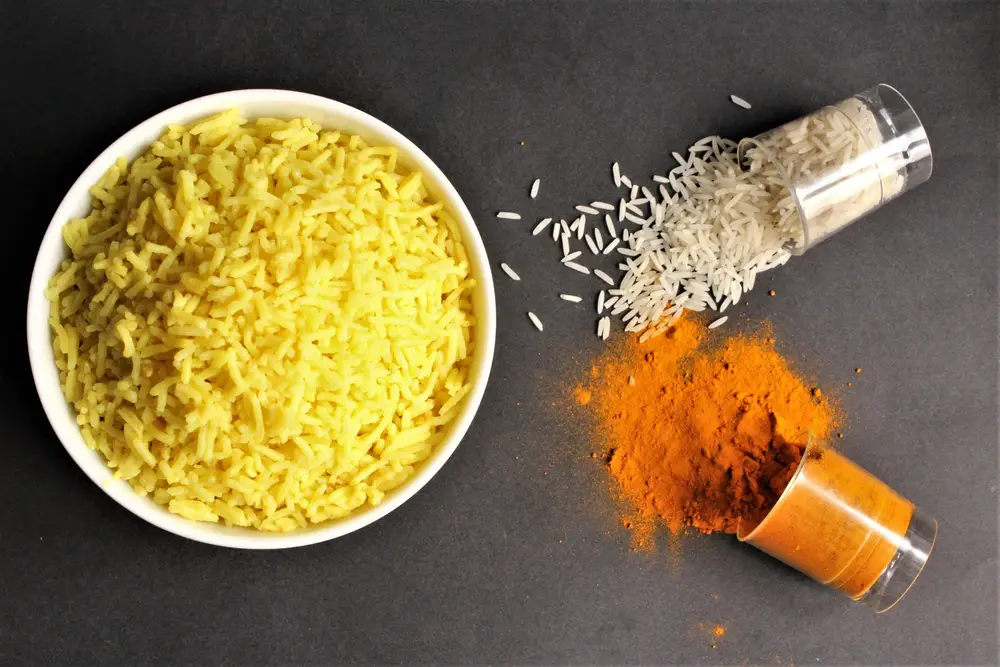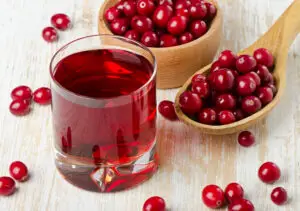Yellow rice has become a popular choice for many due to its vibrant colour and appetizing appearance. Often prepared with a mixture of spices, such as saffron or turmeric, this rice variety not only adds a visual appeal to dishes, but also offers an array of flavours.
As people seek healthier dietary options, it’s essential to consider the benefits of yellow rice and what it can offer for overall health and wellbeing.
While it does not contain substantial amounts of key nutrients like beta-carotene, vitamin A, vitamin C, or lutein+zeazanthin, and has notably low fibre content, yellow rice still provides some health advantages.
It is a good source of various minerals, including calcium, iron, magnesium, phosphorus, potassium, sodium, and zinc.
What Is Yellow Rice
Yellow rice is a popular staple food in many Asian countries, as well as other regions across the globe. This colourful variation of rice gets its distinct hue from the use of turmeric, saffron, or both, which are added during the cooking process.
Turmeric and saffron are known for their flavour and health benefits, which contribute to the overall appeal of yellow rice.
In China, yellow rice is commonly referred to as “java rice,” while in Mexico, it goes by the name “Arroz Amarillo.” The vibrant appearance of yellow rice makes it an attractive dish, as it can be paired with various ingredients such as vegetables, meats, and seafood to create a wide range of delicious meals.
Although yellow rice primarily uses white rice as its base, incorporating spices like turmeric and saffron offers potential health benefits. Turmeric is known for its anti-inflammatory properties, while saffron has been linked to improved mood and potentially reduced symptoms of depression.
However, it is essential to note that the nutritional value of yellow rice may differ slightly from other rice types, such as brown rice or wild rice, which are generally higher in fiber, vitamins, and minerals.
Overall, yellow rice is a versatile and flavourful grain that can be enjoyed as part of a balanced diet. When consumed in moderation, it provides a delicious and colourful addition to various dishes, serving as a staple food in many cultures around the world.
Main Nutritional Components of Yellow Rice
Carbohydrates and Energy
Yellow rice is primarily a source of carbohydrates, providing around 32.96 grams per cup of cooked rice. This makes it a useful source of energy, as it contributes to approximately 12% of the daily recommended intake of carbohydrates.
The total caloric content of one cup is around 150 calories, which can fuel daily activities and support various bodily functions.
Protein and its Role
As an essential component of a healthy diet, protein plays a crucial role in building and maintaining muscles, skin, and other organs.
Yellow rice contains approximately 7-8% protein, with 6 grams of protein per cup of cooked rice. Although this is not a significant source of protein compared to animal products or legumes, it can still contribute to meeting daily protein requirements when consumed as part of a balanced diet.
Fat Content in Yellow Rice
The fat content in yellow rice is relatively low, with around 0.27 grams of total fat per cup of cooked rice. However, it is essential to note that about 2% of this fat consists of omega-6 fatty acids.
These fatty acids are considered pro-inflammatory, which may cause health problems if consumed in excessive amounts. Therefore, it is necessary to consider the overall intake of omega-6 fatty acids from various sources to maintain a balanced and healthy diet.
Comparison with Other Types of Rice
White Rice
White rice is the most common type of rice consumed, with the outer bran and germ layers removed, leaving only the polished endosperm. This process results in a rice that is less nutritious than other varieties such as brown and black rice.
While white rice is versatile and easy to prepare, it has a higher glycemic index compared to other types, which may raise blood sugar levels quickly. However, within white rice varieties, basmati rice is considered healthier, while white jasmine rice is known to trigger high blood sugar and insulin levels.
Brown Rice
Brown rice is whole grain rice that retains its bran and germ layers, providing more fibre, vitamins, and minerals than white rice. The increased fibre content in brown rice can help with digestion and may promote satiety. It also has a lower glycemic index compared to white rice, making it a better option for those with diabetes, prediabetes, or those working on blood sugar control.
Despite taking a bit longer to cook, brown rice is a nutritious choice that makes a great addition to a balanced diet.
Black and Wild Rice
Black rice, also known as forbidden rice or purple rice, is a type of whole grain rice with a dark colour and a unique nutty flavour. It is rich in nutrients, particularly anthocyanins, which are antioxidant compounds also found in blueberries and blackberries. These compounds have been linked to numerous health benefits, including reduced inflammation, improved heart health, and protection against certain cancers.
Wild rice, which is technically not rice but a grass seed, is another healthy alternative to white rice. It has a nutty taste, chewy texture, and relatively higher amounts of protein, fibre, and vitamins compared to other rice varieties. Like black rice, wild rice also contains antioxidant compounds, promoting overall health and wellbeing.
Both black and wild rice have lower glycemic index values compared to white and brown rice, making them suitable for those looking to maintain stable blood sugar levels.
Although their cooking times may be longer than white rice, the added nutritional benefits make them worthwhile choices for a wholesome diet.
Mineral Composition in Yellow Rice
Magnesium and Iron
Yellow rice is a good source of essential minerals like magnesium and iron. Magnesium is vital for maintaining healthy nerve and muscle function, as well as supporting the immune system.
Iron, on the other hand, is crucial for producing red blood cells and transporting oxygen throughout the body. 100 grams of uncooked yellow rice contains 112mg of magnesium, which accounts for 27% of the daily value, and 2.5mg of iron, fulfilling 32% of the daily value.
Sodium Content
Sodium plays a significant role in maintaining the balance of fluids in the body. Yellow rice has a moderate sodium content, which may vary depending on the specific recipe used.
It is essential to consume a balanced amount of sodium, as excessive intake could lead to high blood pressure and other health issues.
Calcium and Potassium in Yellow Rice
Yellow rice also provides important minerals like calcium and potassium. Calcium is crucial for maintaining strong bones and teeth, while potassium helps regulate fluid balance and maintain normal blood pressure.
In 100 grams of uncooked yellow rice, there are 35mg of calcium (4% daily value) and an adequate amount of potassium.
Additionally, yellow rice contains other essential trace minerals such as phosphorus, zinc, manganese, and selenium, contributing to various bodily functions and overall health.
By incorporating yellow rice into a balanced diet, one can obtain multiple nutritional benefits from its mineral composition.
Vitamin Profile in Yellow Rice
Yellow rice, often made from enriched white rice, contains essential vitamins that contribute to its health benefits. The vitamin content primarily includes B-complex vitamins, and in some cases, Vitamin A. Let’s explore these vitamins further.
Vitamin B Complex
Yellow rice provides an array of B-complex vitamins, such as thiamine, riboflavin, niacin, vitamin B-6, and folate. When enriched white rice is used as the base, you can expect added nutritional benefits from this dish. For instance, one cup of cooked enriched white rice contains 153 micrograms of folate and 1.9 milligrams of iron.
The B vitamins play a vital role in many bodily functions, including the support of energy production and the maintenance of a healthy nervous system.
- Thiamine (B1): Assists in breaking down carbohydrates and is crucial for the nervous system’s functioning.
- Riboflavin (B2): Aids in energy production and supports healthy skin, eyes, and nervous system.
- Niacin (B3): Helps with energy production and the regulation of cholesterol levels.
- Vitamin B-6: Vital for brain development, immune function, and the metabolism of proteins and other nutrients.
- Folate (vitamin B-9): Required for DNA synthesis, red blood cell formation, and healthy cell division.
Vitamin A in Yellow Rice
Vitamin A may be present in yellow rice if the dish includes ingredients that contain this nutrient. For example, if the yellow colour comes from the addition of turmeric or saffron, there might be trace amounts of vitamin A.
However, the primary source of vitamin A would likely be from vegetables, such as carrots or bell peppers, that are commonly added to yellow rice dishes. Vitamin A is necessary for proper vision, immune system function, and cell growth.
In conclusion, while yellow rice offers several B-complex vitamins and potentially trace amounts of vitamin A, be mindful of the other ingredients in the dish, as they can also provide additional nutritional benefits or drawbacks.
Keeping it balanced and including vegetables can further enhance the healthiness of a yellow rice meal.
Health Benefits from Yellow Rice
Yellow rice is a popular grain that provides several health benefits. Despite being low in fibre, it is a good source of essential minerals such as calcium, iron, magnesium, phosphorus, potassium, sodium, and zinc. These minerals play crucial roles in maintaining various bodily functions, including bone health, heart function, and blood pressure regulation.
One of the main components that give yellow rice its distinctive colour is turmeric, a spice derived from the ground root of the turmeric plant. Turmeric contains a potent natural antioxidant called curcumin, known for its anti-inflammatory properties. These properties may help in reducing inflammation in the body, thus lowering the risk of chronic diseases like heart disease and certain cancers. In addition, curcumin’s immune-boosting capabilities contribute to a robust immune system.
Incorporating yellow rice in a balanced diet can be beneficial for those with high blood pressure, as this grain serves as a good source of potassium and magnesium. Both minerals are essential for maintaining optimal cardiovascular health, healthy blood pressure levels, and reducing the risk of heart disease.
While yellow rice may not be as nutrient-dense as whole-grain varieties like brown and black rice, it can serve as a healthier alternative to white rice due to its lower glycemic index (GI). Foods with a lower GI have been shown to promote feelings of fullness and aid in maintaining stable blood sugar levels, making yellow rice a promising option for people with diabetes or insulin resistance.
In conclusion, yellow rice can be a valuable addition to a varied diet, providing essential nutrients and offering potential health benefits. Its vibrant colour also adds visual appeal to dishes, making it an attractive choice for a healthy and satisfying meal.
Ingredients That Make Yellow Rice Yellow
Yellow rice derives its characteristic colour primarily due to the addition of spices like turmeric and saffron. These spices not only impart a bright yellow hue to the rice but also contribute to their potential health benefits.
Turmeric in Yellow Rice
Turmeric, scientifically known as Curcuma longa, is a widely used spice in various cuisines around the world. It contains an active compound called curcumin, which is responsible for its vibrant yellow colour.
Curcumin is believed to possess numerous health benefits, such as antioxidant, anti-inflammatory, and anticancer properties. Adding turmeric to yellow rice enhances the nutritional value of the dish, making it a healthier option compared to plain white rice.
In addition to its potential health benefits, turmeric also imparts a mild, earthy flavour to yellow rice, making it a versatile side dish that pairs well with different meals.
Saffron in Yellow Rice
Saffron is another popular spice used to colour and flavour yellow rice. Derived from the stigmas of the Crocus sativus flower, saffron is considered the world’s most expensive spice due to its labor-intensive harvesting process. Apart from its intense yellow-orange colour, saffron adds a distinct aroma and taste to the rice.
Although saffron does not have the same range of health benefits as curcumin, it still offers some potential advantages. It contains various compounds such as carotenoids, which act as antioxidants, and may contribute to maintaining eye health, enhancing mood, and supporting cognitive function.
By incorporating turmeric and saffron into yellow rice, not only is the dish visually appealing and flavourful, but it also offers potential health benefits thanks to these two spices. Combining these ingredients with a balanced and varied diet can make yellow rice a nutritious and delicious addition to your meals.
Yellow Rice in Diets
Yellow rice is a popular dish made by cooking white rice with spices like saffron or turmeric, which give it a bright yellow colour1. Its nutritional profile is similar to white rice, but with additional health benefits from the spices used.
Despite the relatively high carbohydrate content, yellow rice can be a part of a healthy diet if consumed in moderation. It is naturally gluten-free, making it a suitable option for people with celiac disease or gluten intolerance.
In addition, the spices used in yellow rice, such as turmeric, have been associated with various health benefits, including anti-inflammatory properties, which can be helpful in managing chronic conditions.
When it comes to weight loss, incorporating yellow rice into a balanced diet depends on calorie intake and portion sizes.
As a refined grain, it may not be the best choice for people suffering from obesity or aiming for weight loss, since these grains are often lower in fibre and other nutrients, and may not promote satiety as effectively as whole grain alternatives.
In summary, yellow rice can be included in a variety of diets as long as it is consumed mindfully and in moderation. People with diabetes or weight management concerns should pay close attention to portion sizes and consider choosing whole grain or high-fibre alternatives for improved satiety and more balanced nutrition.
Ways to Enhance Nutritional Value
Yellow rice can be a delicious addition to your meals, but choosing the right ingredients and preparation methods can significantly improve its nutritional value.
By incorporating whole grains, using enriched rice, and adding vegetables and nutritious stock, you can make yellow rice a healthier option for your diet.
One way to enhance the nutritional benefits of yellow rice is to use whole grains, such as brown rice instead of white rice. Brown rice retains the bran and germ, which are rich in fibre, vitamins, and minerals.
Additionally, opting for enriched rice will provide you with extra nutrients, including iron, zinc, and B vitamins, which are crucial for maintaining good health.
Adding a variety of colourful vegetables, such as bell peppers, peas, and carrots, to your yellow rice will not only make it more visually appealing, but also increase its nutritional value. Vegetables are packed with vitamins, minerals, and antioxidants, which contribute to overall health and well-being.
Choosing a low-sodium, nutritious stock for cooking the rice can also greatly affect the health benefits of yellow rice. High sodium levels have been associated with an increased risk of high blood pressure and heart disease. By selecting a vegetable or chicken stock that is low in sodium, you can reduce these potential risks while enhancing the flavour of the dish.
In conclusion, following these suggestions can improve the nutritional value of yellow rice without sacrificing its taste. By using whole grains, enriched rice, adding a variety of vegetables, and cooking with a low-sodium, nutritious stock, you can enjoy a delicious and healthier version of this popular dish.

I’m Jennifer a beauty and wellness expert. I believe in promoting a sustainable and healthy lifestyle from within. Helping people feel good is my passion; whether it’s teaching yoga or offering skincare advice.








